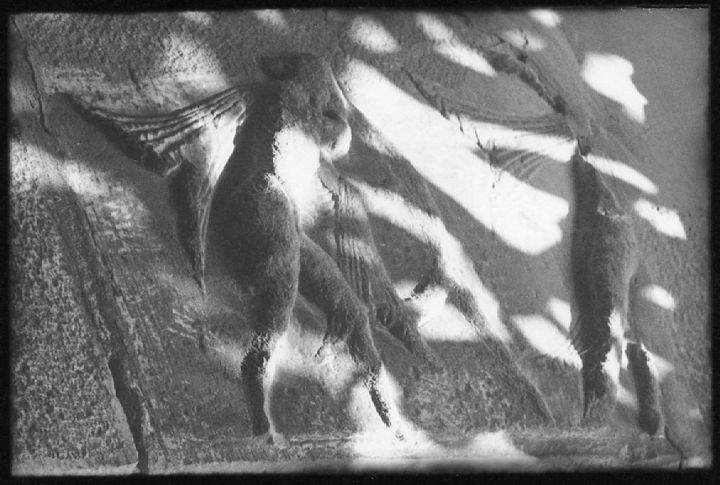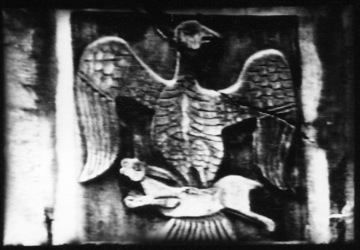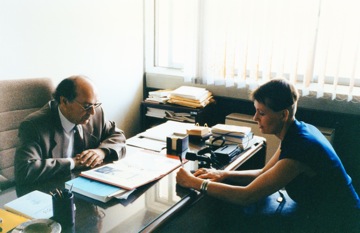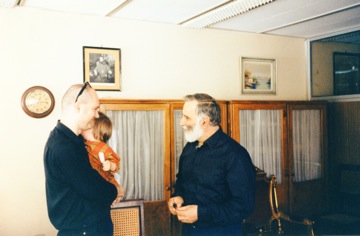
'Four-leaf clover' (behind/rollover 'The catch'). Images of selected marble and sandstone slabs built into the exterior walls of the Middle Byzantine church Panagia Gorgoepikoos in the centre of Athens, Greece. Mixed photo/graphics technique. From the project 'Panagia Gorgoepikoos' by Åsa Lie & Jadran Sturm. 1991-93, Athens, Greece. With the support of Konstnärsnämnden/The Swedish Art Council (3 months in residence grant), a grant from the Swedish embassy in Athens and the Natsios family.
PANAGIA GORGOOEPIKOOS 2021 (PDF)
Realised with support from "Flanders, State of the Art".

A short historical summary
Panagia Gorgoepikoos is a small, Middle Byzantine church from the 12th century, located in Pláka, the center of Athens. Bishop Michael Akominatos (1150-1210) was the founder, and he wanted this church to be a monument over Ancient, early Christian and Byzantine art.
The building is a puzzle constructed of deconstructions, since the reliefs were parts of other monuments or buildings in the past. There are about 100 marble and sandstone slabs built into the exterior walls, dating from 300 before to 1200 after Christ. There are symbols, images, inscriptions and ornaments from different times, cultures and areas, such as Persia, Mesopotamia, Ancient Greece, The Roman Empire, Jewish, Coptic, Orthodox, Catholic and Islamic.
The church has several names. "Panagia Gorgoepikoos" means the one who fulfills your prayers quickly. "Hagios Eleutherios" is the saint and protector of pregnant women, birth and children. "Katholikon" was the name Frankish Catholics used while they ruled in Attica, and for a short period after 1863 the church was called "Sotiros" - "The Saviour". Today, "Mikri Mitropoli" - "The small Cathedral" is most common.

Hagios Eleutherios is built upon the place of an ancient Greek temple which was dedicated to the goddess Elitheia, the protector of pregnancy and birth. The church was a part of the monastery H. Nikolaos and used by the bishops of Athens as a private chapel.
During the occupation of Athens in 1827, the monastery and the church was ruined. In the 1830's a major restoration was carried out. The bell-tower was removed, and inside the four light monolithic marble columns which supported the octagon-cupola were replaced by heavy square pillars. Also the window frames are new. From 1839 to 1842, Mikri Mitropoli was used as a municipal library, (the forerunner of the national library). After another restoration the building was used as a church from 1863.
The church is built in the Greek-cross domed octagon plan with a narthex and measures 7,32 x 12,25 x 11,30 meters. The interior of the church was covered with frescoes and there were icons, marble armchairs, candelabras, lamps, censers. Only two frescoes are left, Jesus the Pantocrator and Mother Mary with Jesus the child.
During our work with Panagia Gorgoepikoos, we met and discussed various aspects of this church with
Dinos Christianopoulos, poet, gallerist, publisher in Thessaloniki.
Petros Vassiliadis, Professor of The New Testament, author, Department of Theology, University of Thessaloniki
Jorgos Antorakis, professor of Byzantine church history, department of Theology, University of Athens.
Nikolaos Chronis, professor of philosophy, department of Philosophy, University of Athens.
Stefanos Avramidis, Orhtodox priest, the church of Agios Haralabos, Athens.
Markos Vidalis, catholic priest, the Roman Catholic church St. Denis, Athens.
Yannis Natsios, theology student, university of Thessaloniki, Eleftheroupoli.
M. Voytyras, professor of Ancient history, department of Archeology, university of Thessaloniki.
Thank you for your personal, philosophical, historical and theological input!

